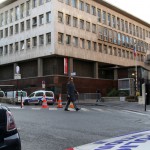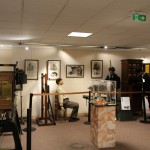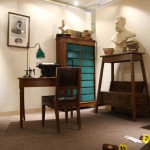Research trip to the „Musée de la Préfecture de Police“ in Paris/France, January 2015
The museum of the police prefecture of Paris is located in the centre of town. It is only a five minute walk from the “Ile de la Cité”, the central court of Paris and the historical Prefecture where in nineteenth century Alphonse Bertillon resided in the upper stories as the head of the department of judiciary identification. The museum is however not housed equally grandiose, but in the third storey of a post-war concrete building. Already in the forecourt a sombre looking police officer blocks my way, the secret parole “museum” changes his expression and he leads me through a door. Here again, in a dark waiting room, ripe with the smell of the self-service coffee machine, faded posters of police announcements and wanted posters, I am lost. Another obstacle, this time a desk manned by a team of officers, has to be overcome before I am granted access to the elevator.
Right opposite of the entrance door to the museum there’s a section on the “Scientific Police”, mainly on Bertillon’s work. An accumulation of framed photographs and texts as well as objects introduces the development of identification and scientific police work. Among these are reproductions of historical photographs, of the process of taking anthropometric measurements, the archive of the Bertillonage records, tables for the portrait parlé, as well as crime scene photographs and reproductions of fingerprints. A huge enlarger takes up much of the space, but leaves room for a staged photo shooting – wooden posing chair and historical camera. Two puppets are representing a seated suspect under the gaze of a photographer whose face is clearly modelled on Bertillon – here he is the “Father of Scientific Detection” standing right in front of me, but slightly stiff. Another puppet operates a small wooden ordering cabinet for the Bertillonage identification cards, as it was used in the introductory phase of the new technique of biometric identification. By the beginning of the twentieth century, the records filled endless rows of shelves in the former police archive and a team of clerks were employed to order and retrieve the identification cards. Some of the cards and judiciary photographs are now kept in the archive of the Police Prefecture that I could visit on my last trip to Paris. In a corner a suitcase of instruments for taking the eleven anthropometric measurements of the Bertillonage rests in a vitrine.
When I arrive at the museum for a second time and ask for an appointment with a curator, the staff leads me into a small office. Even though my earlier message apparently didn’t reach her the woman greets me enthusiastically, as if she’d expected me. The room is overflowing with papers, boxes, objects – like tidal waves this ocean crashes onto her table. She tells me the museum has been redone recently and this also affected the presentation of the “Scientific Police”. Formerly the reconstruction of the Bertillonage photographic studio was presented below a fake ceiling that was supposed to represent the former studio layout and the huge windows in the upper stories of the old police prefecture. Now the artifacts are presented in a more neutral manner, his time it’s the paneled ceiling of last century’s office architecture. Not all of the object are originals – some were built at later stages – but the camera, the archiving cupboard as well as the suitcase for anthropometric instruments are originals. Soon, she tells me, they will receive the original posing chair that was used until a couple of years ago in the active police work of the Prefecture. Only the recently introduced digital and biometric visual recording made the chair obsolete.
The “Musée de la Prefecture de Police” was founded in 1909 in response to the 1900 World Expo held in Paris by Louis Lépine (Prefect of Police), known as an advocate of scientific police work and for his skill in putting down rebellions. This early focus on modern criminology, the history of the police in Paris and on educational aspects concerning police work apparently still informs the presentation of the museum. Even though the museum was founded during the lifetime of Bertillon it does not include the objects and the huge wooden exhibition architecture that were used to present Bertillon’s inventions on international congresses and exhibitions around the turn of the century. Apparently this influential exhibit that successfully promoted Bertillonage in Europe was lost. Also a lot of knowledge on the processes of the Bertillonage, on the photographic and anthropometric instruments seems to be lost – the curator tells me that the prime source of information on historical equipment for the museum staff is a nineteen century publication on the Bertillonage instruments. There is few information on the history and development of the museum, except for a 1933 publication on the collection, she tells me that she is currently working on a historical overview that is supposed to close this gap.
The curator emphasises that Bertillon entered the police service not as a scientist and without a diploma, but as a clerk and practitioner and self-educated expert in anthropology, statistics, and human physiognomy. His most important achievements lay not in scientific research, but in the classification and the practical layout of the archival system of identification and the development of photographic techniques. In scientific circles the Lyon-based Alexandre Lacassange and his disciple Edmond Locard received more recognition for their advances in criminology and scientific police work. She cautions also not to underrate the importance of the Dreyfus affair in late nineteenth century where Bertillon stood witness against the suspected traitor to the nation and was eventually proved wrong. This was a severe blow to Bertillon’s career and still heavily influences the recognition of his work to date. Nevertheless, around the turn of the century he stood out as an expert in photography, reproduction, identification, and was in charge of the most extensive collection of anthropometric data and judiciary portraits at the time. Numerous experts came to visit Bertillon in Paris; among those were the Italian positivist criminologist Césare Lombroso and the Victorian scientist Francis Galton.













